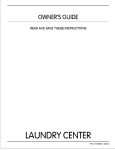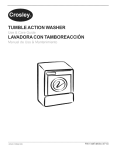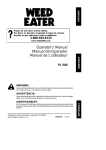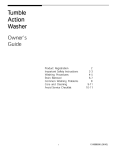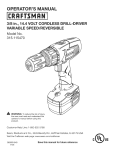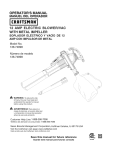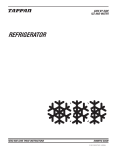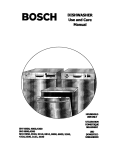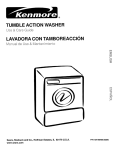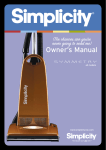Download Frigidaire GLWS1339CS Top Load Washer
Transcript
OWNER’S GUIDE READ AND SAVE THESE INSTRUCTIONS WASHER 1 Versión en español Sideseaobtenerunacopiaenespañolde esteManualdelUsuario,sírvaseescribir aladirecciónqueseincluyeacontinuación. SolicitelaP/N131684000. Spanish Owner's Guides FrigidaireHomeProducts P. O. Box 212378 Augusta, GA 30917 Important Safety Instructions Read all instructions before using this washer. Toreducetheriskoffire,electricalshock,orinjurytopersonswhen using this washer, comply with the basic warnings listed below. Failuretocomplywiththesewarningscouldresultinseriouspersonalinjuries. Prevent Fire Product Registration Thank you for choosing this washer. This owner's guide will explain proper operation and care. Do not wash items that have been previously cleaned in, soaked in, orspottedwithgasoline,cleaningsolvents,kerosene,cookingoils,waxes,etc.Do not store these items on or near the washer. These substances give off vapors or chemicalreactionsthatcouldigniteorexplode. Record Your Model and Serial Numbers Do not put oily or greasy rags or clothing on top of the washer. Thesesubstancesgiveoffvaporsthatcouldignitethematerials. Record below the model and serial numbers found on the washer serial plate located on the underside of the washer lid. Keep these numbers for futurereference. Do not add gasoline, cleaning solvents, or other flammable or explosive substances to the wash water. These substances give off vapors that couldigniteorexplode. Model Number _______________ Serial Number _______________ Date of Purchase ________________ Register Your Product The self-addressed PRODUCT REGISTRATION CARD should be filledincompletely,signedand returned. Under certain conditions, hydrogen gas may be produced in a hot water system that has not been used for 2 weeks or more. HYDROGEN GAS IS EXPLOSIVE. If the hot water system has not been used for such a period, before using the washer, turn on all hot water faucets and let the water flow from each forseveralminutes. Thiswillreleaseanyaccumulatedhydrogengas. Hydrogengas is flammable; do not smoke or use an open flame during this time. Failuretocomplywiththesewarningscouldresultinfire,explosion,serious bodily injury and/or damage to the rubber or plastic parts of the washer. Protect Children This Owner's Guide provides general operatinginstructionsforyour washer.Italsocontainsinformation aboutfeaturesforseveralother models. Your washer may not have everyfeatureincludedhere. Use the washer only as instructed in this Owner's Guide and the Operating Instructions card included with your washer. FOR YOUR SAFETY Do not store or use gasoline or other flammable vapors or liquids in the vicinity of this or any other appliance. Do not allow childrento play on or in the washer.Close supervision of children is necessary when the washer is used near children. As children grow, teach them the proper, safe use of all appliances. Destroythecarton,plasticbagandotherpackingmaterialsafterthe washer is unpacked. Children might use them for play. Cartons covered with rugs, bedspreads or plastic sheets can become airtight chambers. Keep laundry products out of children's reach. To prevent personal injury,observeallwarningsonproductlabels. Before the washer is removed from service or discarded, remove the washer lid to prevent accidental entrapment. Failuretocomplywiththesewarningscouldresultinseriouspersonalinjuries. © 1999 White Consolidated Industries, Inc. Allrightsreserved. PrintedinU.S.A. 2 Important Safety Instructions(continued) Avoid fire hazard or electrical shock. Do not use an adaptor plug or extension cord or remove grounding prong from electrical power cord. Failure to follow this warning can cause serious injury, fire or death. Prevent Injury To prevent shock hazard and assure stability during operation, the washermustbeinstalledandelectricallygroundedbyaqualifiedservicepersonin accordancewithlocalcodes.Installationinstructionsarepackedinthewasherfor installer'sreference.RefertoINSTALLATIONINSTRUCTIONSfordetailedgrounding procedures. If the washer is moved to a new location, have it checked and reinstalledbyaqualifiedserviceperson. To prevent personal injury or damage to the washer, the electrical power cord of the washer must be plugged into a properly grounded and polarized 3-prong outlet. The third grounding prong must never be removed. Never ground the washer to a gas pipe. Do not use an extension cord or an adaptor plug. Follow package directions when using laundry products. Incorrect usage canproduce poisonous gas--resulting inserious injury ordeath. • Do not combine laundry products for use in 1 load unless specified on the label. • Do not mix chlorine bleach with ammonia or acids such as vinegar. • CORRECT Use this way ONLY Do not use or mix liquid chlorine bleach with other household chemicals such as toilet cleaners, rust removers, acid or products containing ammonia. These mixtures can produce dangerous fumes which can cause serious injury or death. • • To prevent serious personal injury and damage to the washer: All repairs and servicing must be performed by an authorized servicer unless specifically recommended in this Owner's Guide. Use only authorized factoryparts. Do not tamper with controls. Do not install or store the washer where it will be exposed to the weather. ALWAYS disconnect the washer from the electrical supply before attemptinganyserviceorcleaning.Failuretodosocanresultinelectricalshockor injury. To prevent injury, do not reach into the washer while parts are moving. Beforeloading,unloadingoraddingitems,pushinthecycleselectorknob and allow the tub to coast to a complete stop before reaching inside. Failuretocomplywiththesewarningscouldresultinseriouspersonalinjuries. This washer is equipped with an electrical overload protector. The motor will stop if it becomes overheated. The washer will automatically restart after a cool down period of up to 30 minutes, if the washer has not been manually turned off duringthistime. SAVE THESE INSTRUCTIONS Note: The instructions appearing in this Owner's Guide are not meant to covereverypossibleconditionand situation that may occur. Common sense and caution must be practiced wheninstalling,operatingand maintaininganyappliance. 3 Washing Procedures • Follow the guidelines below for preparing the wash load. • Read the Operating Instructions card for operating your specific model. • Always read and follow fabric care and laundry product labels. Toreducetheriskoffire,electricalshock,orinjurytopersons,read Important Safety Instructions Instructions, pages 2-3, before operating this washer. 1. Sort laundry into loads that can be washed together. Sort laundry into loads that can be washed together. Sort items by recommended water temperatures, wash time, and agitate/spin speeds. • Separate white, light, and colorfast items from dark and noncolorfast items. • Separate items which shed lint from items which attract lint. Permanent press,synthetic,knitandcorduroyitemswillpickuplintfromtowels,rugs andchenillebedspreads. • Separateheavilysoileditemsfromlightlysoileditems. • Separatelacy,sheerandlooselyknititemsfromsturdyitems. 2. Prepare items for washing. • • • • • • • Empty pockets. Brush off lint and dirt. Shake out rugs and beach towels. Closezippers,fastenhooks,tiestringsandsashes,andremovenonwashable trims and ornaments. Remove pins, decorative buttons, belt buckles, and other objects which could be damaged. This also helps protect other items in the wash load. Mend rips and tears to prevent further damage during washing. Placedelicateitemssuchasbras,shoulderpads,hosiery,andbeltsinamesh bag to prevent tangling during the wash cycle. Turnknititemsinsideouttopreventpilling. Empty pockets. 3. Pretreat stains and heavy soil. SeeStain Removal Removal, pages 6-7, for details. 4. Add a measured amount of detergent to the wash tub before adding the laundry load. Follow detergent manufacturer's directions. The amount required depends on typeofdetergent,loadsizeandsoillevel,andwaterhardness. 5. If desired, add liquid bleach to Bleach Dispenser (some models). • Beforeaddingthewashload,addliquidbleachtobleachdispenserlocated inleftfrontcornerunderthelid: • 3/4 cup (180 ml) for small loads • 1 cup (240 ml) for large loads • 1-1/4cups(300ml)forextra-largeloads. • Then add 1 cup (240 ml) water to flush the dispenser. • Do not use powdered bleach in the bleach dispenser. Place delicate items in a mesh bag. For models without a bleach dispenser, dilute the recommended amount of liquid chlorine bleach in 1 quart (.95 L) water. Add it to wash water after a few minutes of agitation. Do not pour bleach directly on wash load. Bleach Dispenser (some models) 4 Washing Procedures (continued) Do not load items above top row of holes in wash tub. 6. Add laundry load to washer. • Dry load level should not be higher than top row of holes in wash tub. Do not overload washer. • Do not put items on top of agitator or wrap them around it. Load items evenly. • Combinelargeandsmallitemsinaload.Loadlargeitemsfirst. Largeitems should not be more than half the total wash load. • When washing a single heavy item, add 1 or 2 towels to balance the load. 7. If desired, add liquid fabric softener to Fabric Softener Dispenser (some models). For models with a built-in dispenser (see picture to the left): 1. Add liquid softener to the dispenser, following fabric softener label directions. 2. Addwatertobringliquidleveltofilllineondispensercap. 3. Remove the dispenser from the agitator after each use. Rinse both cap and cup with warm water. Replace dispenser in the agitator. Built-InFabricSoftenerDispenser (some models) NOTE: To separate cap from cup, put thumb into dispenser and push against side of cup (see picture to the left). After cleaning, push cap and cup firmly together. Replace dispenser by lining up the ribs and grooves and snapping it intoposition. Fabric softener will be flushed from area under the built-in fabric softener dispenser when Large Load Water Level is selected. If a build-up of fabric softener occurs, clean with hot water. DO NOT REMOVE SERVICE CAP. For models with a removable dispenser (see picture below to the left): 1. Attachfabricsoftenerdispensertotopofagitatorbypressingdowngently. 2. Addsoftenertothedispenser,followingfabricsoftenerlabeldirections. 3. Add water to bring liquid level to top of the peg in the center of the cup. 4. Remove the dispenser from the agitator after each use. Rinse both lid and bowl thoroughly with warm water. Reassemble and place dispenser on agitatororstoreitnearby. Built-InFabricSoftenerDispenser (some models) For models without a fabric softener dispenser, follow fabric softener label directions.Adddilutedfabricsoftenertothefinalrinse.Donotpourfabric softener directly on the wash load. 8. Set cycle selector knob and washer controls according to type, size, and soil level of each load, and detergent used. See Operating Instructions card for your specific model controls. Removable Fabric Softener Dispenser (some models) 5 Washing Procedures 9. Start the washer. Close the washer lid and pull out the cycle selector knob. Washer will fill and agitatewiththelidopen.Thetubwillnotspinunlessthelidisclosed. (continued) • To stop the washer, push in the cycle selector knob. • Donotstopandrestartwasherduringaspinwhenusingthefabricsoftener dispenser. • Tochangeacycle,pushinthecycleselectorknob.Turnitclockwisetothe desiredsetting.Pullouttheknobtorestartthewasher. 10. Remove items when the cycle is completed. Foryoursafety,thelidlockswhenthetubisspinning.Itwillremainlockedfor about 1 minute after the tub stops spinning. • Toopenthelidduringaspin,pushinthecycleselectorknobandwaitabout 1 minute for the lid lock to release. Do not force open the locked lid. Placewasheditemsinautomaticdryer,linedry,ordryflatasdirectedbyfabric carelabel.Excesswrinkling,colortransferorodorsmaydevelopinitemsleftin the washer after the cycle has ended. Toavoidseriouspersonalinjury,donotoperatewasherifsafetylid lock is missing or damaged. Stain Removal Safe Stain Removal Procedures Toreducetheriskoffireorseriousinjurytopersonsorproperty, comply with the basic warnings listed below: • Read and comply with all instructions on stain removal products. • Keep products in their original labeled containers and out of children's reach. • Thoroughly wash any utensil used. • Do not combine stain removal products, especially ammonia and chlorine bleach. Dangerous fumes may result. • Never wash items which have been previously cleaned in, washed in, soaked in or spotted with gasoline, dry cleaning solvents or other flammable or explosive substances because they give off vapors that could ignite or explode. • Never use highly flammable solvents, such as gasoline, inside the home. Vapors can explode on contact with flames or sparks. Do not combine stain removal products. For successful stain removal: • Remove stains promptly. Followfabriccarelabelinstructions. • Determine the kind of stain, then follow recommended treatment in the stain removal chart on the next page. • To pretreat stains, use a prewash product, liquid detergent, or a paste made from granular detergent and water. • Use cold water on unknown stains because hot water can set stains. • Check care label instructions for treatments to avoid on specific fabrics. • Check for colorfastness by testing stain remover on an inside seam. • Rinse and wash items after stain removal. 6 Stain Removal STAIN TREATMENT Adhesive tape, chewing gum, rubber cement Apply ice. Scrape off excess. Place stain face down on paper towels. Saturate with prewash stain remover or nonflammable dry cleaning fluid. Babyformula,dairy products, egg Use product containing enzymes to pretreat or soak stains. Soak for 30 minutes or more. Wash. Beverages(coffee,tea,soda, juice,alcoholicbeverages) Pretreat stain. Wash using cold water and bleach safe for fabric. Blood Rinse with cold water. Rub with bar soap. Or, pretreat or soak with product containing enzymes. Wash using bleach safeforfabric. Candle wax, crayon Scrape off surface wax. Place stain face down between paper towels. Press with warm iron until wax is absorbed. Replace paper towels frequently. Treat remaining stain with prewash stain remover or nonflammable dry cleaning fluid. Hand wash to remove solvent. Wash using bleach safe for fabric. Chocolate Pretreat or soak in warm water using product containing enzymes. Wash using bleach safe for fabric. Collarorcuffsoil,cosmetics Pretreat with prewash stain remover or rub with bar soap. Dye transfer on white fabric Use packaged color remover. Wash using bleach safe for fabric. Grass Pretreat or soak in warm water using product containing enzymes. Wash using bleach safe for fabric. Grease,oil,tar(butter,fats, saladdressing,cookingoils, cargrease,motoroils) Scrape residue from fabric. Pretreat. Wash using hottest water safe for fabric. For heavy stains and tar, apply nonflammable dry cleaning fluid to back of stain. Replace towels under stain frequently. Rinse thoroughly. Wash using hottestwatersafeforfabric. Ink Some inks may be impossible to remove. Washing may set some inks. Use prewash stain remover, denatured alcohol or nonflammable dry cleaning fluid. Mildew, scorch Wash with chlorine bleach if safe for fabric. Or, soak in oxygen bleach and hot water before washing. Badly mildewed fabrics may be permanently damaged. Mud Brush off dry mud. Pretreat or soak with product containing enzymes. Mustard, tomato Pretreat with prewash stain remover. Wash using bleach safe for fabric. Nailpolish May be impossible to remove. Place stain face down on paper towels. Apply nail polish remover to back of stain. Repeat, replacing paper towels frequently. Do not use on acetate fabrics. Paint,varnish WATER BASED: Rinse fabric in cool water while stain is wet. Wash. Once paint is dry, it cannot be removed. OIL BASED AND VARNISH: Use solvent recommended on can label. Rinse thoroughly before washing. Perspiration Use prewash stain remover or rub with bar soap. Rinse. Wash using nonchlorine bleach in hottest water safe for fabric. Rust, brown or yellow discoloration For spots, use rust remover safe for fabric. For discoloration of an entire load, use nonchlorine bleach.Do not use chlorine bleach because it may intensify discoloration. Shoepolish LIQUID: Pretreat with a paste of granular detergent and water. PASTE: Scrape residue from fabric. Pretreat with prewash stain remover or nonflammable dry cleaning fluid. Rinse. Rub detergent into dampened area. Wash using bleachsafeforfabric. Urine, vomit, mucus, feces Pretreat or soak in product containing enzymes. Wash using bleach safe for fabric. 7 Common Washing Problems Manywashingproblemsinvolvepoorsoilandstainremoval,residuesoflintandscum,andfabricdamage.Forsatisfactorywashing results, follow these suggestions provided by The Soap and Detergent Association. PROBLEM POSSIBLE CAUSES SOLUTIONS Blue stains •Detergentorliquidfabricsoftener didnotdissolveordisperse. •If caused by detergent, mix 1 cup (240 ml) •Add detergent before wash load. Then start washer. white vinegar with 1 quart (.95 L) water in aplasticcontainer.Soakitem1hour.Rinse. •Ifcausedbyfabricsoftener,rubstainswith •Dilutefabricsoftenerwithwater. bar soap. Wash. Discoloration, graying •Not enough detergent. •Wash water temperature too low. •Incorrectsorting. •Rewash with correct amount of detergent and hottest water safe for fabric. Add bleachsafeforfabric. •Sortitemsbysoillevelandcolor. •Use correct amount of detergent, hottest water and bleach safe for fabric. Greasy, oily stains •Not enough detergent. •Undilutedliquidfabricsoftener poureddirectlyonfabric. •Treat with prewash stain remover or liquid detergent. •Increase detergent and water temperature. Rewash. •Rubfabricsoftenerstainswithbarsoap. •Use correct amount of detergent and hottestwatersafeforfabric. •Do Do not pour liquid fabric softener directly on fabric. See package directions or Washing Procedures for proper diluting. Holes, tears, or snags •Incorrectuseofchlorinebleach. •Unfastenedzippers,hooks,buckles. •Rips, tears and broken threads. •Overloading the washer. •Degradationoffabric. •Maybeirreversibleifrips,tearsandseams cannot be mended. •Never pour chlorine bleach directly on fabric. •Check condition of items before washing. See Washing Procedures for preparing and loading the wash load. Lint •Incorrectsorting. •Tissuesleftinpocket. •Overloading the washer. •Not enough detergent. •Undissolveddetergenthasleft residue. •Staticclingisattractinglint. •Load washed too long. •Reduce load size. Rewash using correct water temperature, water level, and amount of detergent. •Add nonprecipitating water conditioner to wash water. • Addliquidfabricsoftenertofinalrinse. •Dryloadindryer. •Removelintwithlintbrushorroller. •See Washing Procedures for sorting and preparing the wash load. •Do not overload washer. •Use correct amount of detergent, water temperature and water level. Pilling •Pillingisnormalwithsyntheticand (Fibersbreakoff,ball permanentpressfabrics.Thisisdue up and cling to to abrasion from normal wear. fabric) •Use a lint brush or shaver to remove pills. PREVENTIVE MEASURES •Use fabric softener in the washer to lubricate fibers. •When ironing, use spray starch or fabric finishoncollars andcuffs. •Turn items inside out to reduce abrasion. Residue or powder •Undissolveddetergent. on dark items; •Some nonphosphate granular Stiff,harshfabrics. detergents can combine with hard water minerals to form a residue. •Reduceloadsize. •Add dissolved detergent to tub . Rewash load. •Mix 1 cup (240 ml) white vinegar to 1 gallon (3.8 L) warm water in plastic container. Soak item. Rinse and rewash. •Increase water temperature using hottest watersafeforfabric. •Do not overload washer. •Use liquid detergent or use nonprecipitating water conditioner with nonphosphate granulardetergent. Wrinkling •Overloading the washer. •Reduceloadsize. •Rinseincoldwaterwithliquidfabric softener. •Do not overload washer. •Remove items from washer as soon as cycle iscompleted. •Useliquidfabricsoftener. Yellow buildup of body soil on syntheticfabrics •Agitationtimetooshort. •Wash water temperature too low. •Not enough detergent. •Soak in detergent booster or product containing enzymes. •Wash in hot water (120°F/49°C) using full permanentpresscycle.Increasedetergent. Addbleachsafeforfabric. •Or,treatwithcolorremover. •Wash synthetics frequently using water at least 100°F (37°C ) and correct water level. Yellow or brown ruststains •Iron or manganese in water supply, water pipes, or water heater. •Torestorediscoloredloadofwhites,use rustremoversafeforfabric. Do not use chlorine bleach to remove rust stains. It may intensify discoloration. •Use nonprecipitating water softener. •Before washing, run hot water for a few minutestoclearlines. •Drainwaterheateroccasionally. •For an ongoingproblem,installan iron filter in your water supply system. 8 Care and Cleaning Use care with laundry products. They can damage finish on the washer. Inside • Removeitemsfromthewasherassoonasthecycleends.Excesswrinkling,color transfer, and odors may develop in items left in the washer. • Dry the washer top, the area around the lid opening, and the underside of the lid.Theseareasshouldalwaysbedrybeforethelidisclosed. • Before cleaning the washer interior, unplug the electrical power cord to avoidelectricalshockhazards. • When extremely soiled items have been washed, a dirty residue may remain on the tub. Remove this by wiping the tub with a nonabrasive household cleanser. Rinse thoroughlywith water. • The agitator or tub may become stained from fabric dye. Clean these parts with anonabrasivehouseholdcleanser.Thispreventsdyetransfertofutureloads. Outside • When washing is completed, wipe top and sides of washer with a damp cloth. Turn water faucetsoff to preventpressurebuild-upin the hoses. • As needed, clean the cabinet with mild soap and water. Never use harsh, grittyorabrasivecleansers.Iftoporlidbecomesstained,cleanwithdiluted chlorinebleach[1/2cup(120ml)in1quart(.95L)water].Rinseseveraltimes withclearwater. • Remove glue residue from tape or labels with a mixture of warm water and mild detergent.Or,touchresiduewiththestickysideofthetapeorlabel. • Before moving the washer, place a strip of cardboard or thin fiberboard under thefrontlevelinglegstopreventfloordamage. Winterizing Instructions If the washer is stored in an area where freezing can occur or moved in freezing temperatures, follow these winterizing instructions to prevent damage to the washer: Follow Winterizing Instructions for cold weather care. 1. 2. 3. 4. 5. 6. 7. 8. Turnoffwatersupplyfaucets. Disconnect hoses from water supply and drain water from hoses. Plugelectricalcordintoaproperlygroundedelectricaloutlet. Add1gallonnontoxicrecreationalvehicle(RV)antifreezetoemptywashtub. Closelid. Setcycleselectorknobataspinsetting.Pulloutknobandletwasherspinfor 1minutetodrainoutallwater.NotalloftheRVantifreezewillbeexpelled. Pushinknob,unplugelectricalpowercord,drytubinterior,andcloselid. Storewasherinanuprightposition. To remove antifreeze from washer after storage, run empty washer through a complete cycle using detergent. Do not add wash load. 9 Avoid Service Checklist Beforecallingforservice,reviewthislist.Itmaysavebothtimeandexpense.Thelistincludes common concerns that are not the result of defective workmanship or materials in this washer. OCCURRENCE POSSIBLE CAUSE SOLUTION "Clunking" or gear sounds. A certain amount of "clunking" or gear soundsarenormalinaheavy-dutywasher. Thisisnormal. Rattling and clanking noise. Foreignobjectssuchascoinsorsafetypins may be in tub or pump. Stop washer and check tub. If noise continues after washer is restarted, objects may be in pump. Call your authorizedservicer. Beltbucklesandmetalfastenersarehitting wash tub. To prevent unnecessary noise and damage to tub, fastenfastenersandturnitemsinsideout. Squealing sound or hot rubber odor. Washer is overloaded. Do not overload washer. Stop washer and reduce load. Thumping sound. Heavy wash loads may produce a thumping sound. This is usually normal. If sound continues, washer is probably out of balance. Stop washer and redistribute wash load. Vibrating noise. Washerisnotrestingfirmlyonfloor. Movewashersoitrestsfirmlyonfloor.Adjustleveling legs. See INSTALLATION INSTRUCTIONS for details. Shipping bolt and block have not been removedduringinstallation. See INSTALLATION INSTRUCTIONS for removing shippingboltandblock. Wash load unevenly distributed in tub. Stop washer and rearrange wash load. Electrical power cord may not be plugged in or connection may be loose. Makesureplugfitstightlyinwalloutlet. Housefuseblown,circuitbreakertripped, or a power outage has occurred. Reset circuit breaker or replace fuse. Do not increase fusecapacity.Ifproblemisacircuitoverload,haveit corrected by a qualified electrician. If problem is a poweroutage,calllocalelectriccompany. Water supply faucets are not turned on. Turn on water supply faucets. Cycleselectorisnotincorrectposition. Moveindicatorclockwiseslightly.Pulloutknob. Motor is overheated. Washermotorwillstopifitbecomesoverheated. Itwill automatically restart after a cool down period of up to 30 minutes (if washer has not been manually turned off). Washer won't spin. Lidisnotcompletelyclosed. Closelidcompletely. Residue left in tub. Heavilysoileditems. Wipe tub with a nonabrasive household cleanser, then rinse. Shake or brush excess dirt and sand from items before washing. NOISE OPERATING Washer does not start. 10 OCCURRENCE POSSIBLE CAUSE SOLUTION WATER Washer is overloaded. Do not overload washer. See Washing Procedures. Load is out of balance. Rearrange load to allow proper spinning. Drainhoseiskinked. Straightendrainhose. Water supply is not adequate in area. Checkanotherfaucetinthehouse. Waituntilwater supplyandpressureincrease. Water supply faucets are not completely open. Fully open hot and cold faucets. Water is being used elsewhere in the house. Water pressure must be at least 30 psi (260 kPa). Avoid running water elsewhere while washer is filling. Water inlet hoses are kinked. Straightenhoses. Improperwaterlevelselection(formodelswith waterlevel/loadsizecontrol). Selecthigherwaterlevel/loadsize. Washer is overloaded. Do not overload washer. When control is set at highestfilllevel,dryloadlevelshouldnotbehigher than top row of circular holes in wash tub. Hotwaterheaterissettooloworisadistance from washer. Measure hot water temperature at nearby faucet with candy or meat thermometer. Water temperatureshouldbeatleast130°F(70°C).Adjust waterheaterasnecessary. Hotwaterisbeingusedelsewhereinthehouse. Avoid using hot water elsewhere before or during washer use. There may not be enough hot water availableforpropercleaning.Ifproblempersists, your hot water system may be unable to support more than 1 use at a time. Water in washer does not drain or drains slowly. Drain hose is kinked or clogged. Clean and straighten the drain hose. Water leaks. Fillhoseconnectionatfaucetorwasher. Checkandtightenhoseconnections.Installrubber sealingwashersprovided. House drain pipes are clogged. Unclog drain pipes. Contact plumber if necessary. Oversudsing. Uselessdetergent. Incorrect wash and rinse temperatures. Hot and cold water hoses are connected to wrong supply faucets. Connect hot water hose to hot water faucet and cold water hose to cold water faucet. Water is entering washer but tub does not fill. Drainhosestandpipeisincorrectheight. Standpipe must be a minimum of 33" (83.82 cm) high to prevent siphoning. See INSTALLATION INSTRUCTIONS. Wash load too wet after spin. Water does not enter washer or it enters slowly. Water level does not cover load. Warm or hot water is not hot enough. 11 FRIGIDAIRE GALLERY TOP LOAD WASHER WARRANTY (UNITED STATES) YourFrigidaireproductisprotectedbythiswarranty WARRANTY PERIOD FRIGIDAIRE, THROUGH ITS AUTHORIZED SERVICERS, WILL: THE CONSUMER WILL BE RESPONSIBLE FOR: FULL ONE-YEAR WARRANTY One year from original purchase date. Pay all costs for repairing or replacing any parts of this appliance which prove to be defective in materials or workmanship. Costs of service calls that are listed under NORMAL RESPONSIBILITIES OF THE CONSUMER.* LIMITED 2ND - 5TH YEAR WARRANTY Second through fifth years from original purchase date. Provide a replacement for a defective or malfunctioning part found in the washer transmission (illustrated below). Costs for labor and replacement parts other than defective transmission parts. FULL 25-YEAR INNER WASH BASKET WARRANTY (Excluding Alaska) 25 years from original purchase date. Provide a replacement and in-home service labor, without charge, for an inner wash basket (illustrated below) that breaks due to defective materials or workmanship. Costs of service calls that are listed under NORMAL RESPONSIBILITIES OF THE CONSUMER.* LIMITED WARRANTY (Applicable to the State of Alaska) Time periods listed above. All of the provisions of the full and limited warranties above and the exclusions listed below apply. Costs of the technician's travel to the home and any costs for pick up and delivery of the appliance required because of service. Your appliance is warranted by Frigidaire Home Products, a division of White Consolidated Industries, Inc. We authorize no person to change or add to any of our obligations under this warranty. Our obligations for service and parts under this warranty must be performed by Frigidaire or an authorized Frigidaire servicer. This warranty applies only to products in ordinary household use, and the consumer is responsible for the items *NORMAL listed below: RESPONSIBILITIES 1. Proper use of the appliance in accordance with instructions provided with the product. OF THE CONSUMER 2. Proper installation by an authorized servicer in accordance with instructions provided with the appliance and in accordance with all local plumbing, electrical and/or gas codes. 3. Proper connection to a grounded power supply of sufficient voltage, replacement of blown fuses, repair of loose connections or defects in house wiring. 4. Expenses for making the appliance accessible for servicing, such as removal of trim, cupboards, shelves, etc., which are not a part of the appliance when it was shipped from the factory. 5. Damages to finish after installation. 6. Replacement of light bulbs and/or fluorescent tubes (on models with these features). EXCLUSIONS This warranty does not cover the following: 1. CONSEQUENTIAL OR INCIDENTAL DAMAGES SUCH AS PROPERTY DAMAGE AND INCIDENTAL EXPENSES RESULTING FROM ANY BREACH OF THIS WRITTEN OR ANY IMPLIED WARRANTY. Note: Some states do not allow the exclusion or limitation of incidental or consequential damages, so this limitation or exclusion may not apply to you. 2. Service calls which do not involve malfunction or defects in workmanship or material, or for appliances not in ordinary household use. The consumer shall pay for such service calls. 3. Damages caused by services performed by servicers other than Frigidaire or its authorized servicers; use of parts other than genuine Frigidaire Home Products parts; obtained from persons other than such servicers; or external causes such as abuse, misuse, inadequate power supply or acts of God. 4. Products with original serial numbers that have been removed or altered and cannot be readily determined. IF YOU NEED SERVICE Keep your bill of sale, delivery slip, or some other appropriate payment record. The date on the bill establishes the warranty period should service be required. If service is performed, it is in your best interest to obtain and keep all receipts. This written warranty gives you specific legal rights. You may also have other rights that vary from state to state. Service under this warranty must be obtained by contacting Frigidaire Home Products: 800 • 944 • 9044 Frigidaire Home Products P.O. Box 212378 Augusta, GA 30917 Product features or specifications as described or illustrated are subject to change without notice. All warranties are made by White Consolidated Industries, Inc. This warranty applies only in the 50 states of the U.S.A. and Puerto Rico. 12 Service Information (Canada) To avoid unnecessary cost and inconvenience, make a few simple checks before calling for service. Common occurrences and their solutions can be found in the AvoidServiceChecklist.Besureyouhavefollowedtheinstructionsinthismanual. Ifyouareunabletolocatethecauseofaproblem,callforservice.Insistonfactory service by an authorized FRIGIDAIRE HOME PRODUCTS PARTS AND SERVICE depot. FRIGIDAIRE HOME PRODUCTS PARTS AND SERVICE All Frigidaire appliances are backed by FRIGIDAIRE HOME PRODUCTS PARTS AND SERVICE, one of Canada's largest parts and service networks. TheFrigidairereputationmeansyoucanenjoycompleteprofessionalservicefrom oneofourhundredsoftrainedtechniciansacrossthecountry.AskyourFrigidaire dealer for details about the Extended Service Plan offered by FRIGIDAIRE HOME PRODUCTS PARTS AND SERVICE to all purchasers of Frigidaire appliances in Canada. FRIGIDAIRE HOME PRODUCTS PARTS AND SERVICE 7075 Ordan Drive Mississauga,Ontario L5T 1K6 Place the name, address and telephone number of your service depot in the spaces below. Product and feature specifications as described or illustrated are subject to change without notice. 13 WARRANTY (CANAD A) (CANADA) GALLERY AUTOMATIC WASHERS AND DRYERS WARRANTOR: Frigidaire Home Products 7075 Ordan Drive Mississauga, Ontario L5T 1K6 For service under this warranty, contact your local dealer/retailer, authorized FRIGIDAIRE HOME PRODUCTS PARTS AND SERVICE depot, or: FRIGIDAIRE HOME PRODUCTS PARTS & SERVICE 7075 Ordan Drive Mississauga, Ontario L5T 1K6 Tel.: (905) 565-9200 Fax: (905) 565-0937 WARRANTY PERIOD: WARRANTOR WILL THROUGH ITS AUTHORIZED SERVICE DEPOT: For the first two years after purchase by the original consumer/owner: Pay all costs to repair or replace any defective parts. Lifetime washer, after purchase by the original consumer/owner: Pay all costs (excluding labour to install) of a polypropylene washer basket and/or polypropylene tub. Top load automatic washers only: transmission for the third through tenth year after purchase by the original consumer/owner: Pay all costs (excluding labour to install) to replace any defective transmission. WARRANTY APPLIES TO: a) Products purchased and installed in Canada for personal single family household use. b) Defects resulting or arising out of the manufacturing process. c) Products bearing legible manufacturer's model and serial numbers. d) Replacement parts only for the remainder of the original warranty. WARRANTY DOES NOT APPLY TO: a) Transportation damage. b) Supply and replacement of porcelain, fuses, glass and light bulbs. c) Parts and service supplied or obtained from other than FRIGIDAIRE HOME PRODUCTS PARTS AND SERVICE or FRIGIDAIRE HOME PRODUCTS PARTS AND SERVICE authorized depots. d) Damage or failure as the result of abuse, improper or commercial use. CONSUMER/OWNER RESPONSIBILITY: a) To provide proof of the original date of purchase by means of a bill of sale or payment record verifying purchase date. b) To pay all costs to make the appliance readily accessible for service. c) To ensure proper power supply and connection of the appliance to same. d) Proper installation, control setting and care of finish. This warranty is in addition to any statutory warranties contained in any applicable legislation. The terms and conditions of this warranty are not intended to exclude or limit your rights under those statutes. The warrantor however reserves the right to charge transportation and travelling costs for distances in excess of 48 kilometres (30 miles) from the nearest FRIGIDAIRE HOME PRODUCTS PARTS AND SERVICE authorized service depot. This warranty plus the statutory warranties mentioned are the only warranties given to the consumer/owner for this product. 14














